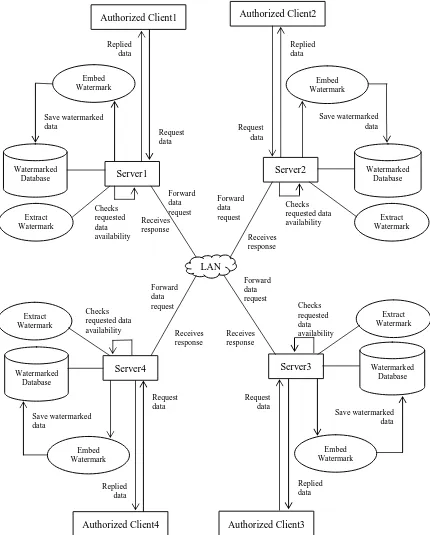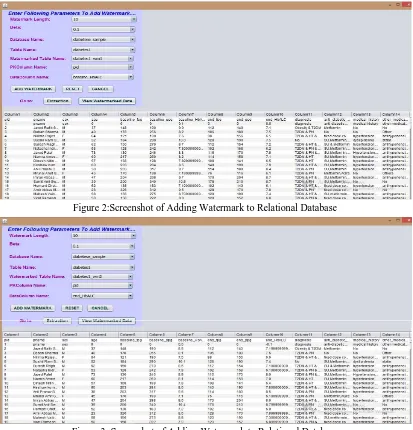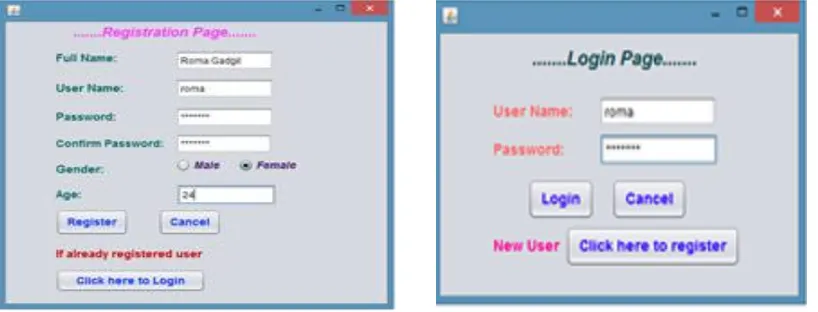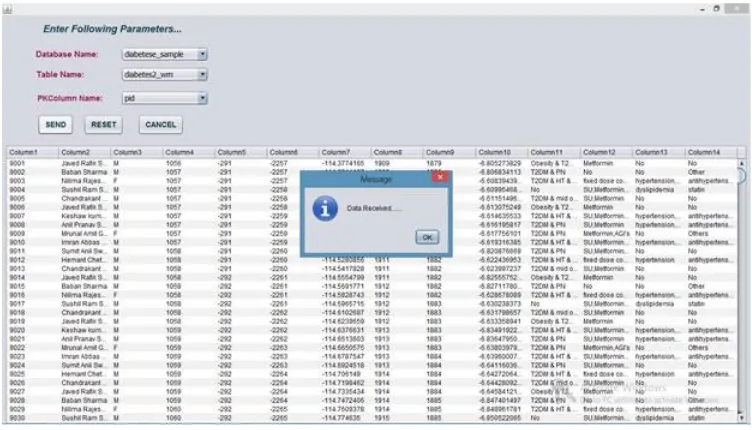ISSN(Online): 2320-9801
ISSN (Print): 2320-9798
I
nternational
J
ournal of
I
nnovative
R
esearch in
C
omputer
and
C
ommunication
E
ngineering
(An ISO 3297: 2007 Certified Organization)
Vol. 4, Issue 7, July 2016
Recoverable Watermarking for Distributed
Databases
Sana Hatture, Prof. Dr. Suhas D. Raut
ME Student, Dept. of Computer Science & Engineering, NK Orchid College of Engineering & Technology, Solapur University, Solapur, Maharashtra, India
Project Guide, Dept. of Computer Science & Engineering, NK Orchid College of Engineering & Technology, Solapur University, Solapur, Maharashtra, India
ABSTRACT: Distributed database security has become an important issue. This paper provides method for providing security to shared databases in distributed environment. Such approach is applied for protecting numerical data in relational databases. Advancement in information technology is playing an increasing role in the use of information systems comprising relational databases. These databases are used effectively in collaborative environments for information extraction; consequently, they are vulnerable to security threats concerning ownership rights and data tampering. Watermarking is advocated to enforce ownership rights over shared relational data and for providing a means for tackling data tampering. The system provides security to the shared databases in distributed environment by recoverable watermarking where different users share their data in various proportions. It also preserves and maintains data quality.
KEYWORDS: Distributed Database,Relational Database,Recoverable Watermarking and Numerical Data
I.INTRODUCTION
Security of relational database is great concern in today’s world because of sharing of data over internet. Data providers create services and make them available to users for searching and accessing purposes. Given that these services may attract more attacks. So it is desire to protect the data and hence providers need some technology that identify the threats and pirated copies unauthorized access to their databases. The increasing use of relational database creates a need for watermarking database. In today's internet based application environment, ownership rights protection on relational database is decisive issue because unauthorized changes to data may have serious consequences and result in significant losses for the organization. Hence right protection through watermarking becomes an important research topic [1].Following is existing system:
Robust and Reversible Watermarking (RRW): Genetic algorithm (optimization algorithm) is employed in the robust and reversible watermarking technique (RRW) to achieve an optimal solution that is feasible for the problem at hand and does not violate the defined constraints. An optimal watermark value is created through the GA and inserted into the selected feature of the relational database in such a way that the data quality remains intact. Mutual Information, a well-known information theory (concept), statistically measures the amount of information that one feature contains about the other features in a database. In RRW, mutual information is used to select a suitable (candidate) feature from the database for watermarking. In RRW, the knowledge of mutual information for every candidate feature is also employed to compute the watermark information. Thus, it is ensured that the data quality will not be affected.The RRW is based on recoverable watermarking numerical data of centralized relational databases[8]. Therefore implemented system provides database security in distributed environment providing recoverable watermarking.
ISSN(Online): 2320-9801
ISSN (Print): 2320-9798
I
nternational
J
ournal of
I
nnovative
R
esearch in
C
omputer
and
C
ommunication
E
ngineering
(An ISO 3297: 2007 Certified Organization)
Vol. 4, Issue 7, July 2016
II.RELATED WORK
In the digital world of today, data is excessively being generated due to the increasing use of the Internet and Cloud Computing. Data is stored in different digital formats such as images, audio, video, natural language texts and relational data. Relational data in particular is shared extensively by the owners with research communities and in virtual data storage locations in the Cloud. The purpose is to work in a collaborative environment and make data openly available so that it is useful for knowledge extraction and decision making.Following are the techniques to ensure security in terms of ownership protection.
Watermarking techniques have historically been used to ensure security in terms of ownership protection and tamper
proofing for a wide variety of data formats. This includes images, audio, video, natural language processing software, relational databases [2] and more.
Reversible watermarking techniques can ensure data recovery along with ownership protection.
Fingerprinting (transactional watermarks), data hashing, serial codes are some other techniques used for ownership
protection [3].
Following are some systems:
The first irreversible watermarking technique for relational databases was proposed by Agrawal et al. [2]. Similarly, thefirst reversible watermarking scheme for relational databases was proposed by Zhang et al. [4]. In this technique, histogram expansion is used for reversible watermarking of relational database. Zhang et al. proposed a method of distribution of error between two evenly distributed variables and selected some initial nonzero digits of errors to form histograms. Histogram expansion technique is used to reversibly watermark the selected nonzero initial digits of errors. This technique keeps track of overhead information to authenticate data quality. However, this technique is not robust against heavy attacks.
Difference Expansion Watermarking techniques (DEW), exploit methods of arithmetic operations on numeric featuresand perform transformations [5]. The watermark information is normally embedded in the LSB of features of relational databases to minimize distortions.
Another reversible watermarking technique proposed is based on difference expansion and support vector regression(SVR) prediction to protect the database from being tampered. The intention behind the design of these techniques is to provide ownership proof. Such techniques are vulnerable to modification attacks as any change in the expanded value will fail to detect watermark information and the original data[6].
Genetic Algorithm based on Difference Expansion watermarking (GADEW) technique is used in a proposed robust andreversible solution for relational databases [7]. GADEW improves upon the drawbacks mentioned above by minimizing distortions in the data, increasing watermark capacity and lowering false positive rate. To this end, a genetic algorithm is employed to increase watermark capacity and minimize introduced distortion. However, watermark capacity decreases with the increase in watermarked tuples. GADEW used the distortion measures to control distortions in the resultant data.
III.SYSTEM ARCHITECTURE
ISSN(Online): 2320-9801
ISSN (Print): 2320-9798
I
nternational
J
ournal of
I
nnovative
R
esearch in
C
omputer
and
C
ommunication
E
ngineering
(An ISO 3297: 2007 Certified Organization)
Vol. 4, Issue 7, July 2016
request for first time, server responds with first watermarked data created. For second request, server responds with second watermarked data. Watermarked data is only known by server as it is the owner of data. Server also extracts the watermark by detecting the watermark. This is recoverable watermarking. It also preservers and maintains data quality by recoverable watermarking.
Figure 1: RWDD System Architecture
Replied data Replied data Save watermarked data Request data Save watermarked data Checks requested data availability Receives response Receives response Checks requested data availability Forward data request Forward data request Checks requested data availability Receives response Forward data request Forward data request Receives response Checks requested data availability Save watermarked data Request data Replied data Request data Save watermarked data Replied data Server1 Watermarked Database Watermarked Database Watermarked Database Watermarked Database Embed Watermark Embed Watermark Embed Watermark Embed Watermark LAN Server4 Server2 Server3 Extract Watermark Extract Watermark Extract Watermark Extract Watermark
Authorized Client4 Authorized Client3 Authorized Client1 Authorized Client2
ISSN(Online): 2320-9801
ISSN (Print): 2320-9798
I
nternational
J
ournal of
I
nnovative
R
esearch in
C
omputer
and
C
ommunication
E
ngineering
(An ISO 3297: 2007 Certified Organization)
Vol. 4, Issue 7, July 2016
IV.IMPLEMENTATION METHOD
A. Description of the Implementation Method:
Following are the functional modules of the system: 1. Server Modules:
Server is the owner of data. First it creates the relational database which is to be watermarked to ensure ownership protection. Then data is distributed over servers. Here horizontal fragmentation is done. Then server performs two tasks: first embeds watermark in relational database by selecting one attribute of numeric data and server extracts watermark by detecting watermark embedded. This is recoverable watermarking. This also preserves and maintains quality of data. Server also performs authentication and authorization of client when it receives data request from client. For this server maintains different database for client. This database contains client details and log file. Client authentication is performed by user id and password. Server allows only read authorization to client for requested data. i. Adding Watermark:
This module adds watermark to data. After creating and fragmenting database server adds watermark to data. First it selects one numeric data attribute which is to be watermarked. Numeric data column is taken from user input. Its parameters are calculated such as min, max, sum, mean and variance of original data. These are parameters before adding watermark.Watermarked string is generated through genetic algorithm and watermark length and beta is taken from user. Beta is watermarking strength, low values of beta preserves data quality. Watermark length, beta, database name, table name and watermarked table name, primary key column and data column are user inputs. After adding watermark again parameters such as min, max, sum, mean and variance of watermarked column is calculated to ensure watermark is embedded.
ii. Extract Watermark:
This is next module after adding watermark. This module extracts watermark. Watermark extraction is performed by detecting watermark. This is called recoverable watermarking. It also preservers and maintains quality of data. It depends on length of watermark.
2. Client Modules:
Client contains three functional modules registration of client, login of client and data request. New client registers on server. Already registered client logged in directly. After logging client send request to server for data. For this database name, table name and primary key column is taken as input from client. Then client send request to server and receives reply from server. This replied data is watermarked but client is unaware about this watermarked data.
V.IMPLEMENTATION TECHNIQUE
The implementation technique to embed watermark can be summarized in following steps:
1) Get the database name, table name, watermark table name, primary key column and numeric data column 2) Genetic Algorithm for generating watermark string
i. Set population size, crossover percentage, mutation rate, elite percentage, database name, table name, primary key column, data column
ii. Calculate min, max, sum, mean and variance of selected data column from original data iii. Initialize population.
iv. Calculate fitness v. Sort population
vi. Select elite chromosomes
vii. Create new chromosomes using crossover viii. Mutate chromosome
ix. Goto step (iv) if end condition is not met
x. Generate watermark string from best chromosome 3) Add watermark string to selected data column
Following are steps of the proposed technique to extract watermark:
1) Get watermark length, database name, table name, watermarked table name, primary key column and data column. 2) Calculate difference of values in data column of original data and watermarked data
ISSN(Online): 2320-9801
ISSN (Print): 2320-9798
I
nternational
J
ournal of
I
nnovative
R
esearch in
C
omputer
and
C
ommunication
E
ngineering
(An ISO 3297: 2007 Certified Organization)
Vol. 4, Issue 7, July 2016
4) Build watermark string by counting votes for each bit Following are the steps of data request from client to server: 1) If new client then register else login
2) Get database name, table name and primary key column. 3) Send request to server
4) Receives reply from server in the form of watermarked data.
VI.RESULTS
System first adds watermark to original data. It can also extract watermark. This preserves data quality. Below figure 2, figure 3, figure 4, figure 5depicts adding watermark to original relational database. Figure 6, figure 7, figure 8and figure 9depict watermark extraction. Figure 10 shows output of watermark extraction. Client registration is shown in figure 11. Figure 12 depicts client login. Client send data request to server is shown in figure 13 and figure 14.
Figure 2:Screenshot of Adding Watermark to Relational Database
ISSN(Online): 2320-9801
ISSN (Print): 2320-9798
I
nternational
J
ournal of
I
nnovative
R
esearch in
C
omputer
and
C
ommunication
E
ngineering
(An ISO 3297: 2007 Certified Organization)
Vol. 4, Issue 7, July 2016
Figure 4: Screenshot of Adding Watermark to Relational Database
Figure 5: Screenshot of Adding Watermark to Relational Database
ISSN(Online): 2320-9801
ISSN (Print): 2320-9798
I
nternational
J
ournal of
I
nnovative
R
esearch in
C
omputer
and
C
ommunication
E
ngineering
(An ISO 3297: 2007 Certified Organization)
Vol. 4, Issue 7, July 2016
Figure 8: Screenshot of Watermark Extraction Figure 9: Screenshot of Watermark Extraction
Figure 10: Screenshot of Output of Watermark Extraction
ISSN(Online): 2320-9801
ISSN (Print): 2320-9798
I
nternational
J
ournal of
I
nnovative
R
esearch in
C
omputer
and
C
ommunication
E
ngineering
(An ISO 3297: 2007 Certified Organization)
Vol. 4, Issue 7, July 2016
Figure 13: Screenshot of Client Data Request
Figure 14: Screenshot of Client Data Request
VI.CONCLUSION AND FUTURE WORK
ISSN(Online): 2320-9801
ISSN (Print): 2320-9798
I
nternational
J
ournal of
I
nnovative
R
esearch in
C
omputer
and
C
ommunication
E
ngineering
(An ISO 3297: 2007 Certified Organization)
Vol. 4, Issue 7, July 2016
REFERENCES
1. Snehal S. Kshatriya and Dr. S. S. Sane, “A Study of Watermarking Relational Databases,” in International Journal of Application or Innovation
in Ebgineering & Management , vol. 3,issue 10, October 2014 .
2. R. Agrawal and J. Kiernan, “Watermarking relational databases,” in Proceedings of the 28th international conference on Very Large Data
Bases. VLDB Endowment, 2002, pp. 155–166.
3. S. Subramanya and B. K. Yi, “Digital rights management,” Potentials, IEEE, vol. 25, no. 2, pp. 31–34, 2006.
4. Y. Zhang, B. Yang, and X.-M. Niu, “Reversible watermarking for relational database authentication,” Journal of Computers, vol. 17, no. 2, pp.
59–66, 2006.
5. G. Gupta and J. Pieprzyk, “Database relation watermarking resilient against secondary watermarking attacks,” in Information Systems Security.
Springer, 2009, pp. 222–236.
6. J.-N. Chang and H.-C. Wu, “Reversible fragile database watermarking technology using difference expansion based on svr prediction,” in
Computer, Consumer and Control (IS3C), 2012 International Symposium on. IEEE, 2012, pp. 690–693.
7. K. Jawad and A. Khan, “Genetic algorithm and difference expansion based reversible watermarking for relational databases,” Journal of
Systems and Software, 2013.
8. Saman Iftikhar, M. Kamran and Zahid Anwar,” A Robust and Reversible Watermarking Technique for Relational Data,” in Knowledge and




